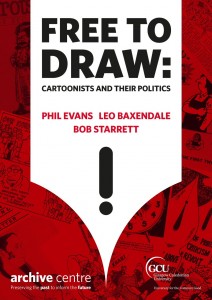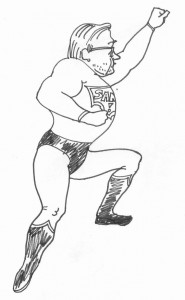 In 2016 Sandy Hobbs added a large cartoon/comic related deposit to his existing collection at GCU. Our debut exhibition of 2017 is ‘Free to Draw: Cartoonists and their Politics’, which draws from both Sandy’s material and from Bob Starrett’s papers. As an introduction Sandy has kindly penned a blog for us ~
In 2016 Sandy Hobbs added a large cartoon/comic related deposit to his existing collection at GCU. Our debut exhibition of 2017 is ‘Free to Draw: Cartoonists and their Politics’, which draws from both Sandy’s material and from Bob Starrett’s papers. As an introduction Sandy has kindly penned a blog for us ~
In the 1990s, when I moved material from my home to GCU to form what became the Sandy Hobbs Collection, the basic loose principles of selection were that what was included would be POLITICAL and from my PAST. Some of what I retained at home might well have gone, but other considerations were at work. Some correspondence with my still living friend Jean McCrindle seemed more personal than political. Writings by E. P. Thompson I kept by me because I still felt the need to consult it regularly.
 Amongst this borderline material were items relating to PHIL EVANS, the socialist cartoonist, who had been married to my sister, Andrea, for a time, and who remained a “family member”, being the father of my niece, Esme. When he died in 2014, it seemed appropriate to add to the collection, not only examples of his political work, but also general drawings and sketches he had done of, for example, Esme and my son, Kevin. (cartoon opposite ‘Super Sandy’ by Phil Evans)
Amongst this borderline material were items relating to PHIL EVANS, the socialist cartoonist, who had been married to my sister, Andrea, for a time, and who remained a “family member”, being the father of my niece, Esme. When he died in 2014, it seemed appropriate to add to the collection, not only examples of his political work, but also general drawings and sketches he had done of, for example, Esme and my son, Kevin. (cartoon opposite ‘Super Sandy’ by Phil Evans)
Then in January 2015, the murderous attack on Charlie Hebdo, got me thinking about political cartooning more generally and this resulted in a decision to offer to the collection material which I had previously thought of as primarily Cartoons rather than Politics.
The first set of material which seemed appropriate concerns LEO BAXENDALE. We worked together in Scottish CND, so he already featured in the archive. However, for a time Lois and I wrote scripts for him when he was the principal artist on the children’s comic, Wham! We have a complete run of the early Wham! Leo would not be thought of primarily as a political cartoonist, but he has a profoundly political world-view, as is clear from the books he published later in life. It would be unhelpful to try to distinguish between political Leo and non-political Leo.
Awareness of this tricky point influenced my approach to selecting cartoon material of a more general sort. It was a straightforward business to pick out, for example, STEVE BELL and VICKY on the left and CUMMINGS on the right. Similarly cartoon books dealing with Hiroshima and the Holocaust were obvious candidates for inclusion. Equally appropriate are cartoon histories of organizations such as the French Socialist Party and the Wobblies. HERGE, the creator of Tintin, is not thought of primarily as a political artist, but he did begin his career on a right wing newspaper in Belgium and an early Tintin adventure was set in the Soviet Union.
For a time, I subscribed to the satirical magazines, CANARD ENCHAINE and PRIVATE EYE. Cartoons are a prominent part of both publications. I once contributed a story about the political content of a children’s comic to Private Eye, but have forgotten the date.
In the 1960s I had a particular interest in writing about children’s comics, which had been aroused in my time working with Leo Baxendale. There are thus in my files short articles on comics contributed to Solidarity Scotland, Glasgow Choice, which was a consumers’ newsletter, and into the 1970s, Socialist Worker. There is also a draft article on Leo which was rejected by a fine arts magazine and a piece on comics which I think had been prepared as part of a scheme Leo had to start a new comic. My writing on comics tailed off until an “interview” concocted by David Cornwell and myself for a fanzine called Fusion. David and I also published a paper on the Gorbals vampire hunt, which devote a lot of space to the supposed role played by “horror comics” in that phenomenon. In 1981 I curated a small exhibition at Paisley College and in 1988 I organize a session at an event, What’s Left, organized by Marxism Today at Glasgow College. All of this activity was “political” to varying extents and, of course, largely about cartoons.
After a good deal of soul searching on the question of which cartoons could be regarded as relevant to political issues, my son Kevin pointed out to me that much of the material I was thinking of holding back, especially children’s comics, was ephemeral and hence particularly worthy of being saved in an archive. Hence what I have submitted ranges from the explicitly political to material that neither the artists nor their original audiences would have associated with “politics”.